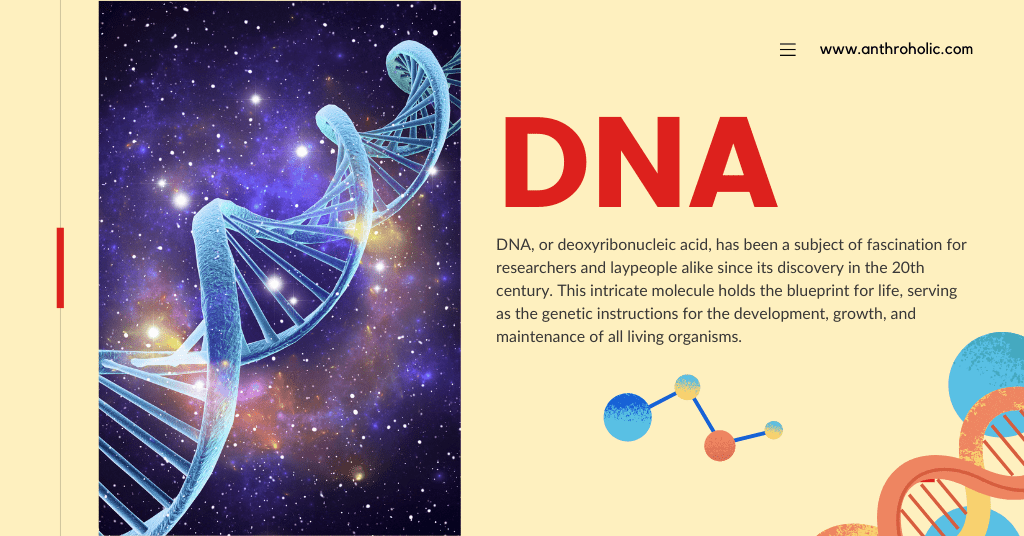AI Answer Evaluation Platform Live Now. Try Free Answer Evaluation Now
DNA
DNA, or deoxyribonucleic acid, has been a subject of fascination for researchers and laypeople alike since its discovery in the 20th century. This intricate molecule holds the blueprint for life, serving as the genetic instructions for the development, growth, and maintenance of all living organisms. It is also an essential component in the field of biology, having significantly advanced our understanding of inheritance, evolution, and the molecular basis of disease.

Structure and Composition of DNA
- The Double Helix DNA is composed of two long strands of nucleotides that coil around each other to form a double helix. This structure was first proposed by James Watson and Francis Crick in 1953 and earned them a Nobel Prize in Physiology or Medicine in 1962 [4]. The double helix allows DNA to be compactly stored within the cell nucleus and to be easily copied during cell division.
- Nucleotides: The Building Blocks Nucleotides are the fundamental building blocks of DNA, consisting of a sugar (deoxyribose), a phosphate group, and one of four nitrogenous bases: adenine (A), thymine (T), cytosine (C), and guanine (G). These bases pair with one another to form the rungs of the DNA ladder: adenine pairs with thymine (A-T), and cytosine pairs with guanine (C-G).
- Chromosomes and Genes DNA is packaged into structures called chromosomes, which are located within the cell nucleus. In humans, there are 46 chromosomes, arranged in 23 pairs. Each chromosome contains thousands of genes, which are segments of DNA that code for specific proteins. These proteins are responsible for the various traits and functions exhibited by living organisms.
| Base 1 | Base 2 |
|---|---|
| Adenine | Thymine |
| Cytosine | Guanine |
DNA Replication and Repair
- Replication Process Before a cell can divide, its DNA must be accurately copied to ensure that the genetic information is passed down to the next generation of cells. This process is called DNA replication and involves unwinding the double helix, separating the strands, and using each strand as a template to synthesize a new complementary strand.
- Repair Mechanisms DNA is constantly subjected to damage from various sources, such as chemicals, radiation, and errors during replication. To maintain the integrity of genetic information, cells have evolved several DNA repair mechanisms, including base excision repair, nucleotide excision repair, and mismatch repair.
Techniques for DNA Analysis
- Polymerase Chain Reaction (PCR) PCR is a revolutionary technique developed by Kary Mullis in 1983, which allows for the amplification of specific DNA sequences [5]. PCR has numerous applications, including DNA cloning, gene expression analysis, and DNA fingerprinting in forensics.
- DNA Sequencing DNA sequencing determines the order of nucleotides within a DNA molecule. The advent of next-generation sequencing technologies has significantly accelerated the speed and reduced the cost of DNA sequencing, allowing for genome-wide analyses and the sequencing of entire human genomes.
- Gene Editing Gene editing technologies, such as CRISPR-Cas9, enable researchers to modify specific DNA sequences within an organism’s genome. These techniques hold great promise for treating genetic diseases, improving agricultural crops, and advancing our understanding of gene function [2].
Latest Advances in Genetic Research
- Personalized Medicine As our understanding of the human genome deepens, personalized medicine is becoming a reality. By analyzing an individual’s genetic makeup, medical professionals can tailor treatments and preventive measures specific to the patient’s needs, ultimately improving healthcare outcomes [1].
- Gene Therapy Gene therapy involves introducing, modifying, or replacing defective genes within a patient’s cells to treat or prevent disease. Recent advances in gene delivery methods and gene-editing tools have brought gene therapy closer to clinical applications, with promising results in treating genetic disorders like cystic fibrosis and inherited retinal diseases [6].
- Epigenetics Epigenetics is the study of heritable changes in gene expression that do not involve alterations to the underlying DNA sequence. Epigenetic modifications, such as DNA methylation and histone modification, play crucial roles in development, aging, and disease. Recent research has shed light on the complex interplay between genetics and environmental factors in shaping our health and susceptibility to disease [3].
Conclusion
The discovery of DNA and the subsequent advances in genetic research have revolutionized the field of biology and our understanding of the molecular basis of life. The study of DNA has led to groundbreaking technologies, such as PCR, DNA sequencing, and gene editing, which have transformed medicine, agriculture, and forensic science. As we continue to unlock the secrets of our genetic code, we can expect further breakthroughs that will reshape our understanding of health, disease, and the very nature of life itself.
Importance of Studying about DNA in Anthropology
The study of DNA has proven to be a valuable tool in the field of anthropology, providing insights into human history, migration patterns, and the relationships between different populations. By analyzing genetic markers within DNA, anthropologists can trace the origins and movements of ancient human populations, reconstructing the complex story of human evolution and migration over time.
One of the key applications of DNA analysis in anthropology is the study of human evolution. By comparing the DNA sequences of modern humans, extinct hominins such as Neanderthals and Denisovans, and other primates, researchers can piece together the evolutionary relationships between these species. These comparisons have led to the discovery that modern humans share a common ancestry with Neanderthals and Denisovans, and that gene flow occurred between these populations [9].
Another important aspect of studying DNA in anthropology is the investigation of human migration patterns. By analyzing genetic markers in various populations, researchers can infer the historical movements of human groups and identify the genetic relationships between different populations. For example, the study of mitochondrial DNA (mtDNA) has revealed the maternal ancestry of human populations and shed light on the “Out of Africa” hypothesis, which posits that modern humans originated in Africa and then migrated to other parts of the world [7].
Finally, DNA analysis has also contributed to our understanding of the population history and cultural practices of specific groups. For instance, by studying the Y-chromosome, researchers can trace paternal lineages and investigate the impact of historical events, such as migrations, conquests, and trade, on the genetic makeup of a population [8].
References
[1] Collins, F. S., & Varmus, H. (2015). A new initiative on precision medicine. New England Journal of Medicine, 372(9), 793-795.
[2] Doudna, J. A., & Charpentier, E. (2014). The new frontier of genome engineering with CRISPR-Cas9. Science, 346(6213), 1258096.
[3] Feinberg, A. P. (2007). Phenotypic plasticity and the epigenetics of human disease. Nature, 447(7143), 433-440.
[4] Maddox, B. (2003). Rosalind Franklin: The dark lady of DNA. Harper Collins.
[5] Mullis, K. (1990). The unusual origin of the polymerase chain reaction. Scientific American, 262(4), 56-61.
[6] Naldini, L. (2015). Gene therapy returns to centre stage. Nature, 526(7573), 351-360.
[7] Cann, R. L., Stoneking, M., & Wilson, A. C. (1987). Mitochondrial DNA and human evolution. Nature, 325(6099), 31-36.
[8] Jobling, M. A., & Tyler-Smith, C. (2003). The human Y chromosome: an evolutionary marker comes of age. Nature Reviews Genetics, 4(8), 598-612.
[9] Reich, D., Green, R. E., Kircher, M., Krause, J., Patterson, N., Durand, E. Y., … & Pääbo, S. (2010). Genetic history of an archaic hominin group from Denisova Cave in Siberia. Nature, 468(7327), 1053-1060.



